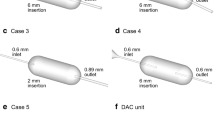Abstract
Purpose. Efficient dispersion of bulk solids is critical for dry powder aerosol production which can be viewed as a sequence of events from stationary through dilated, flowing and finally dispersed particulates. The purpose of this study was to test the hypothesis that numerical descriptors of powder flow properties predict aerosol dispersion and pharmacodynamic effect.
Methods. Drug and excipient particles were prepared in size ranges suitable for inhalation drug delivery, and their physico-chemical properties were evaluated. Novel techniques (chaos analysis of dynamic angle of repose and impact force separation) were developed and utilized to measure and characterize powder flow and particle detachment from solid surfaces, respectively. Dry powder aerosol dispersion was evaluated using inertial impaction. Pharmacodynamic evaluations of bronchodilation were performed in guinea pigs, for selected formulations.
Results. We observed a direct correlation of powder flow with ease of particle separation (r2 = 0.9912) and aerosol dispersion (r2 = 0.9741). In vivo evaluations indicated that formulations exhibiting a higher in vitro dose delivery resulted in a greater reduction in pulmonary inflation pressure.
Conclusions. These results integrate powder behavior at various levels and indicate that numerical descriptors of powder flow accurately predict dry powder aerosol dispersion. A proportionality between aerosol dispersion and pharmacodynamic effect was observed in preliminary in vivo evaluations, which demonstrates the potential of these techniques for correlation studies between in vitro powder properties and in vivo effect.
Similar content being viewed by others
REFERENCES
A. R. Clark. Medical aerosol inhalers: past, present and future. Aerosol Sci. and Tech. 22:374–391 (1995).
S. P. Newman and S. W. Clarke. Therapeutic aerosols, 1, physical and practical considerations. Thorax. 38:881–886 (1983).
G. Scheuch and W. Stahlhofen. Deposition and dispersion of aerosols in the airways of the human respiratory tract: the effects of particle size. Exp. Lung Res. 18:343–358 (1992).
S. P. Newman. In S. W. Clark and D. Pavia (eds), Aerosols and the Lung: Clinical and Experimental Aspects, Butterworths, London, 1984, pp. 197–224.
P. J. Davies, G. W. Hanlon, and A. J. Molyneux. An investigation into the deposition of inhalation aerosol particles as a function of air flow rate in a modified Kirk lung. J. Pharm. Pharmacol. 28:908–911 (1976).
J. Visser. An invited review: Van der Waals and other cohesive forces affecting powder fluidization. Powder Tech. 58:1–10 (1989).
A. J. Hickey, N. M. Concessio, M. M. VanOort, and R. M. Platz. Factors influencing the dispersion of dry powders as aerosols. Pharm. Tech. 18:58–64 (1994).
N. M. Concessio. Dynamic properties of pharmaceutical powders and their impact on aerosol dispersion, thesis, University of North Carolina at Chapel Hill (1997).
A. J. Hickey and N. M. Concessio. Flow properties of selected pharmaceutical powders from a vibrating spatula. Part. Part. Syst. Charac. 11:457–462 (1994).
P. Speiser and R. Tawashi. Misch wirkung Pharmazeutisch ver wendeter Pulvermischer. Pharm. Acta. Helv. 37:529–543 (1962).
J. T. Carstensen. Pharmaceutical Principles of Solid Dosage Forms, Technomic Publishing Company, Lancaster, 1993.
A. J. Hickey and N. M. Concessio. Chaos in rotating lactose powder beds. Particulate Sci. and Tech. 14:15–25 (1996).
N. M. Concessio and A. J. Hickey. Analysis of the patterns of particle dispersion from a dry powder inhaler. Pharm. Tech. 20:50–62 (1996).
A. J. Hickey and N. M. Concessio. Descriptors of irregular particle morphology and powder properties. Adv. Drug Del. Rev. 26:29–40 (1997).
F. C. Moon. Chaotic and Fractal Dynamics, John Wiley and Sons, New York, 1992.
D. Ruelle. Strange attractors. Math Intelligencer 2:126–137 (1980).
B. Kaye. Chaos and Complexity: Discovering the Surprising Patterns of Science and Technology, VCH Publishers, New York, 1993, pp. 64–70.
H. Froehling, J. P. Crutchfield, D. Farmer, N. H. Packard, and R. Shaw. On determining the dimension of chaotic flows. Physica. 3D:605–617 (1981).
J. D. Farmer, E. Ott, and J. A. Yorke. The dimension of chaotic attractors. Physica. 7D:153–180 (1983).
A. Otsuka, K. Kida, K. Danjo, and H. Sunada. Measurement of the adhesive force between particles of powdered organic materials and a glass substrate by means of the impact separation method, I, effect of temperature. Chem. Pharm. Bull. 31:4483–4488 (1983).
B. A. Webber, J. V. Collins, and M. A. Braithewaite. Sever acute asthma: a comparison of three methods of inhaling Salbutamol. Br. J. Dis. Chest. 76:69–74 (1982).
B. S. Cohen. The first 40 years. In J. P. Lodge and T. L. Chan (eds), Cascade Impactor, Sampling and Data Analysis, American Industrial Hygiene Assoc., Ohio, 1986.
J. P. Mitchell, P. A. Costa, and S. Waters. An assessment of an Andersen Mark-II cascade impactor. J. Aerosol Sci. 19:231–221 (1988).
R. M. Auty, K. Brown, M. Neale, and P. D. Snashall. Respiratory tract deposition of sodium cromoglycate is highly dependent upon technique of inhalation using the Spinhaler. Br. J. Dis. Chest. 81:371–380 (1987).
M. VanOort, B. Downey, and W. Roberts. Verification of operating the Andersen cascade impactor at different flow rates. Pharm. Forum. 22:2211–2215 (1996).
N. M. Concessio, R. Jager-Waldau, and A. J. Hickey. Aerosol delivery from an active emission multi-single dose dry powder inhaler. Particulate Sci. Tech. 15:51–63 (1997).
S. Desquand, J. Lefort, C. Dumarey, and B. B. Vargaftig. The booster injection of antigen during active sensitization of guinea pig modifies the anti-anaphylactic activity of the PAF antagonist WEB 2086. Br. J. Pharmacol. 100:217–222 (1990).
D. A. Handley, J. J. DeLeo, and A. M. Havill. Induction of aerosol allergen of sustained and nonspecific IgE-mediated airway hyperactivity in the guinea pig. Agents Actions. 37:201–203 (1992).
H. Konzett and R. Roessler. Versuchsanordnung zu untersuchungen an der Bornchialmuskulatur. Naunyn Schmiedeberg. Arch. Exp. Path. Pharmakol. 195:71–74 (1940).
J. S. Franzone, R. Cirillo, and P. Biffignandi. Doxofylline exerts a prophylactic effect against bronchoconstriction and pleurisy induced by PAF. Eur. J. Pharmacol. 165:269–277 (1989).
Author information
Authors and Affiliations
Corresponding author
Rights and permissions
About this article
Cite this article
Concessio, N.M., VanOort, M.M., Knowles, M.R. et al. Pharmaceutical Dry Powder Aerosols: Correlation of Powder Properties with Dose Delivery and Implications for Pharmacodynamic Effect. Pharm Res 16, 828–834 (1999). https://doi.org/10.1023/A:1018865717374
Issue Date:
DOI: https://doi.org/10.1023/A:1018865717374




